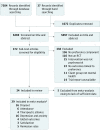Association of Patient Treatment Preference With Dropout and Clinical Outcomes in Adult Psychosocial Mental Health Interventions: A Systematic Review and Meta-analysis
- PMID: 31799994
- PMCID: PMC6902231
- DOI: 10.1001/jamapsychiatry.2019.3750
Association of Patient Treatment Preference With Dropout and Clinical Outcomes in Adult Psychosocial Mental Health Interventions: A Systematic Review and Meta-analysis
Abstract
Importance: Receiving a preferred treatment has previously been associated with lower dropout rates and better clinical outcomes, but this scenario has not been investigated specifically for psychosocial interventions for patients with a mental health diagnosis.
Objective: To assess the association of patient treatment preference with dropout and clinical outcomes in adult psychosocial mental health interventions via a systematic review and meta-analysis.
Data sources: The Cochrane Library, Embase, PubMed, PsychINFO, Scopus, Web of Science, Nice HDAS (Healthcare Databases Advanced Search), Google Scholar, BASE (Bielefeld Academic Search Engine), Semantic Scholar, and OpenGrey were searched from inception to July 20, 2018, and updated on June 10, 2019.
Study selection: Studies were eligible if they (1) were a randomized clinical trial; (2) involved participants older than 18 years; (3) involved participants with mental health diagnoses; (4) reported data from a group of participants who received their preferred treatment and a group who received their nonpreferred treatment or who were not given a choice; and (5) offered at least 1 psychosocial intervention.
Data extraction and synthesis: Two researchers extracted study data for attendance, dropout, and clinical outcomes independently. Both assessed the risk of bias according to the Cochrane tool. Data were pooled using random-effects meta-analyses.
Main outcomes and measures: The following 7 outcomes were examined: attendance, dropout, therapeutic alliance, depression and anxiety outcomes, global outcomes, treatment satisfaction, and remission.
Results: A total of 7341 articles were identified, with 34 eligible for inclusion. Twenty-nine articles were included in the meta-analyses comprising 5294 participants. Receiving a preferred psychosocial mental health treatment had a medium positive association with dropout rates (relative risk, 0.62; 0.48-0.80; P < .001; I2 = 44.6%) and therapeutic alliance (Cohen d = 0.48; 0.15-0.82; P = .01; I2 = 20.4%). There was no evidence of a significant association with other outcomes.
Conclusions and relevance: This is the first review, to our knowledge, examining the association of receiving a preferred psychosocial mental health treatment with both engagement and outcomes for patients with a mental health diagnosis. Patients with mental health diagnoses who received their preferred treatment demonstrated a lower dropout rate from treatment and higher therapeutic alliance scores. These findings underline the need to accommodate patient preference in mental health services to maximize treatment uptake and reduce financial costs of premature dropout and disengagement.
Conflict of interest statement
Figures



Similar articles
-
Systematic reviews of the effectiveness of day care for people with severe mental disorders: (1) acute day hospital versus admission; (2) vocational rehabilitation; (3) day hospital versus outpatient care.Health Technol Assess. 2001;5(21):1-75. doi: 10.3310/hta5210. Health Technol Assess. 2001. PMID: 11532238 Review.
-
Effect of Treatment Preference in Randomized Controlled Trials: Systematic Review of the Literature and Meta-Analysis.Patient. 2019 Dec;12(6):593-609. doi: 10.1007/s40271-019-00379-6. Patient. 2019. PMID: 31372909
-
Dropout From Psychological Interventions for Pathological Health Anxiety: A Three-Level Meta-Analysis of Randomized Controlled Trials.Clin Psychol Psychother. 2024 Sep-Oct;31(5):e3064. doi: 10.1002/cpp.3064. Clin Psychol Psychother. 2024. PMID: 39363535
-
Patient preference for psychological vs pharmacologic treatment of psychiatric disorders: a meta-analytic review.J Clin Psychiatry. 2013 Jun;74(6):595-602. doi: 10.4088/JCP.12r07757. J Clin Psychiatry. 2013. PMID: 23842011 Free PMC article. Review.
-
Psychosocial interventions for preventing and treating depression in dialysis patients.Cochrane Database Syst Rev. 2019 Dec 2;12(12):CD004542. doi: 10.1002/14651858.CD004542.pub3. Cochrane Database Syst Rev. 2019. PMID: 31789430 Free PMC article.
Cited by
-
Understanding and preventing nonadherence and treatment dropout in adolescents and young adults with anxiety and depressive disorders.Front Psychiatry. 2023 Nov 22;14:1174285. doi: 10.3389/fpsyt.2023.1174285. eCollection 2023. Front Psychiatry. 2023. PMID: 38076685 Free PMC article.
-
Eye movement desensitization and reprocessing for depression: a systematic review and meta-analysis.Eur J Psychotraumatol. 2021 Apr 9;12(1):1894736. doi: 10.1080/20008198.2021.1894736. Eur J Psychotraumatol. 2021. PMID: 33889310 Free PMC article. Review.
-
Technology Enabled Clinical Care (TECC): Protocol for a Prospective Longitudinal Cohort Study of Smartphone-Augmented Mental Health Treatment.JMIR Res Protoc. 2021 Jan 14;10(1):e23771. doi: 10.2196/23771. JMIR Res Protoc. 2021. PMID: 33296869 Free PMC article.
-
Online Reviews of Mental Health Treatment Facilities: Narrative Themes Associated With Positive and Negative Ratings.Psychiatr Serv. 2021 Jul 1;72(7):776-783. doi: 10.1176/appi.ps.202000267. Epub 2021 May 21. Psychiatr Serv. 2021. PMID: 34015944 Free PMC article.
-
Effects of patient-driven iCBT for anxiety in routine primary care and the relation between increased experience of empowerment and outcome: A randomized controlled trial.Internet Interv. 2021 Sep 21;26:100456. doi: 10.1016/j.invent.2021.100456. eCollection 2021 Dec. Internet Interv. 2021. PMID: 34603972 Free PMC article.
References
-
- Arnkoff DB, Glass CR, Shapiro SJ. Expectations and preferences In: Norcross JC, ed. Psychotherapy Relationships That Work: Therapist Contributions and Resposiveness to Patients. New York, NY: Oxford University Press; 2002:335-356.
-
- National Institute for Health and Care Excellence Service user experience in adult mental health: improving the experience of care for people using adult NHS mental health services: clinical guideline [CG136]. https://www.nice.org.uk/guidance/cg136/chapter/Personcentred-care. Published December 2011. Accessed March 14, 2019. - PubMed
-
- NHS England The five year forward view for mental health. https://www.england.nhs.uk/wp-content/uploads/2016/02/Mental-Health-Task.... Published February 2016. Accessed January 20, 2019.
Publication types
MeSH terms
LinkOut - more resources
Full Text Sources
Medical

